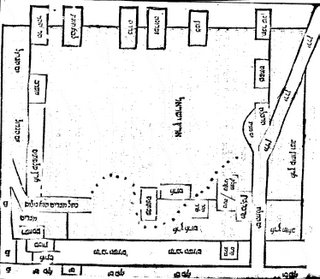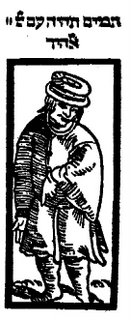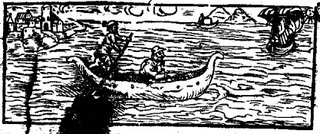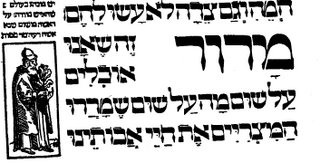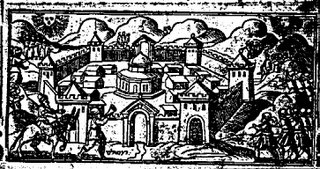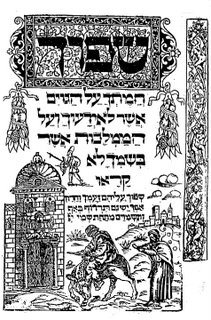Haggadah and the Mingling of the Sexes
I have previously attempted to highlight some of the intricacies and history of illustration in haggadahs. While many of the illustrations which appear in the haggadah are directly related to the text of the haggadah, some also pre-date the haggadah and seder service. That is, although searching for hametz (leaven) happens the night prior to the seder service many times an illustration of cleaning out the hametz and, in turn, searching for it, appears in many haggadahs. Another such illustration is that of the matzo making. There are five basic steps in this process, mixing the flour and water, kneading the dough, rolling out the dough, putting little holes in the dough, and then actually baking it. In the Mantau, 1560 haggadah, an illustration presenting all these steps appears. As you can see, to the far left the process begins with the mixing of the flour and water. This continues through the far right, where the matzo is being put (taken out?) of the oven. An interesting facet of this illustration is the combination of the sexes. That is, both men and women are involved in this process. If one looks closely, (you can click on any of the pages below for a larger image) at the baking stage, a man and a woman are actually jointly operating the oven.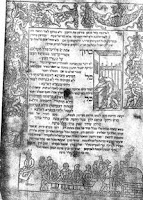 Mantua, 1560
Mantua, 1560
This mixing of the sexes was actually highlighted in the next edition which used this illustrations. In the Mantau, 1568 haggadah the same illustration appears. In this edition, however, there is one addition which does not appear in the original. On top of the illustration appears a legend. It says, “צורת אנשים המסרקים ונשים עשות חלות זקנים עם נערים בחורים גם בתולות” “this is an illustration of the men making holes [in the matzo] and the women rolling the dough, the old with the young, both the bachelors and the virgins [unmarried women]” 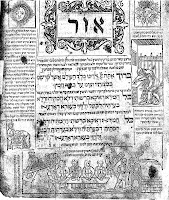 Mantua, 1568
Mantua, 1568
The editors of this edition felt that the inclusion of the sexes in this mitzvah, was a fulfillment of the verse from Psalms 148:12 “the old with the young, both the bachelors and the virgins.” Thus, the combination of a man and a woman at the oven may actually be by design to further highlight this point. It is worthwhile to note that in the Venice, 1609 haggadah, although the same basic illustration appears (the clothing worn is updated) there is no longer a woman at the oven. It is unclear whether this was intentional or not. Venice, 1609
Venice, 1609
It is not a minor point that the editors of the Mantau, 1568 haggadah used this verse to explain the mixing of the sexes. The interpretation of this verse and specifically the use to justify the mixing of the sexes is the subject of some controversy. R. Yosef Steinhardt [1] (1705-1776) records that soon after he became the Rabbi of a town in Alsace it was brought to his attention that it was “customary” to have mixed dancing on the Holidays. The only restriction on the mixed dancing was a government tax was required to engage in mixed dancing. R. Steinhardt, however, refused to allow for the dancing to proceed. As the government lost some of its revenue he was called to account for his actions. In an effort to convince the official of the correctness of his decision to prohibit mixed dancing, he appealed to the Bible. R. Steinhardt noted that the official was also fluent in the Bible and thus it was appropriate to use in this instance. He cited the verse in Jeremiah 31:13 “Then shall the virgin rejoice in the dance, and the young men and the old together.” He noted that it only says the young men and old engaged in dance together but not the virgin. He went on to cite other verses as well. Although he does not cite the above verse from Psalms, one can safely assume that he would explain this verse in a similar fashion to that of the verse in Jeremiah. Namely, it doesn’t state explicitly that the men and women were together only that they both took part in the praise of god. NOTE:
[1] Shu”t Zikrhon Yosef, Fuerth, 1773, O.H. no. 17, it can also be found in Mishna Berura, Biur Halacha, no. 339. This work also contains an interesting introduction. He quotes his wife, Kreindal, who offered the well-known explanation as to why Yosef lost 10 years of his life for listening to his brothers referring to his father, Ya’akov, as Yosef’s master. For each time Yosef heard this inappropriate title used, he lost a year of his life. But, in the Torah, this title only appears five times. Kreindal explained that as Yosef, to keep the charade that he did not understand his brothers, used an interpreter, Yosef heard and understood it ten times, five times from his brothers and five from the interpreter.
Additionally, the introduction to the Shu’T Zikrhon Yosef is also well known for his scathing comments about Hassidim. According to most auction catalogs, this introduction was ripped out by Hassidim. But, in every edition that I have seen, and every time it has come up for auction it always includes the introduction leading one to question whether this is merely apocryphal.



